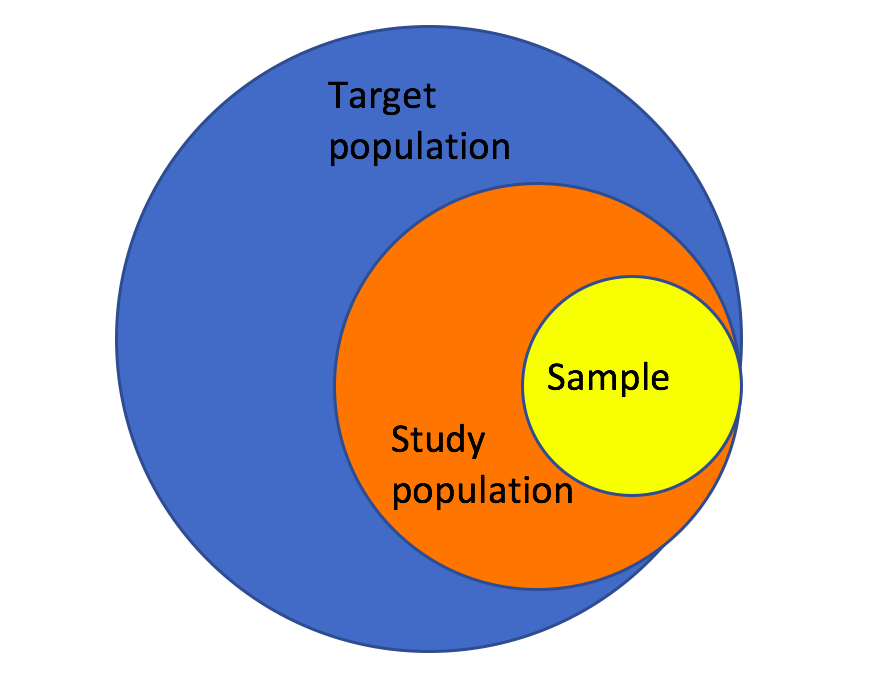
Introduction:
Welcome back to the course. Hope you’re enjoying it so far. In this chapter, you will learn about sampling. By the end of this chapter you would have covered the following topics:
- Sampling definition
- Purposeful sampling
- Types of sampling in qualitative research
- Types of sampling in quantitative research
- Ethical consideration in data collection
What is sampling:
Sampling is a selection process of individuals for a research study. These individuals are selected so that they could represent a larger population.

“A sample is smaller (and hopefully representative) collection of units from population used to determine truths about that population” (Field, 2005)
Population: It is a group of individuals from which the sample comes from.
Target population: The group of people to whom we want our research results to apply
Study population: The people who meet our operational definition of the target population
Research sample: The members of the study population from whom we collect our data from
Think of the study like this:
| Who do you want to generalise to? | The population |
| What population can you get access to? | The study population |
| Who is in your study? | The sample |
Don’t quite get the sampling? No worries, lets go through an example together:
A research study done in Sport School:
- Target population: 14 – 18 years old athletes
- Study population: Athlete in a specific sport school(s) is chosen for this study
Please do note that the definition of the study population and the sampling process can affect the validity of the research. What do I mean by that? If the study population suffers from sampling error, the study population will not be able to correctly represent the target population. Sampling error can occur in two ways:
- Chance
- Sampling bias
In the sampling error of chance, it could be out of pure chance that the participation or sample that you recruited were all outliers, hence giving you the wrong data that is different to the population.
For example: Of the 100 learners in school, you measured the height of 15 learners. It happened by chance that all 15 learners were all taller than 1.95 meters. When the researcher writes this up, the researcher concludes that 1.95 meter is the average height of the population. This is clearly not correct, because it is not possible, but it happened by chance that the average was 1.95 meters tall. Since is was an obvious error, it can be detected and discarded. The problems is when the error presents smaller, and is more difficult to detect. The solution to this is to recruit a big enough sample size that could represent the entire population.
The second error that can occur is sampling bias, when doing research, it is important to make sure that your sample is unbiased. Sampling bias is a tendency to favour the selection of units that have particular characteristics.
For example: A researcher sends out a survey regarding the stress level of students in a program. 100 questionnaire was sent out, and they get a response of 60. Of the total population of 60, 50 say they are not stressed. When this research was being reviewed, the reviewer realised that all the students were in postgraduate courses and had to write a thesis, which was at their own pace.
Sampling:
There are mainly two ways of getting a sample from a study population:
- Probability sampling:
- Non-probability sampling (Ayhan, 2011):
- There are different types of non-probability sampling:
- Quota sampling
- Convenient sampling
- Purposive sampling
- Self-selective sampling
- Snowball sampling
- There are different types of non-probability sampling:
Here is a clip that explains non-probability sampling

Specific sampling:
Now let’s move onto the different types of sampling. There are different types of samples, these types depend on what type of study you want to conduct. The purpose of sampling is to gather information or data on a population and use this information or data to generalise it to the entire population.
Example: There are 5000 students studying accounting, of the 5000 how many students have an Android-powered smartphone?
- Population: 5000
- Study population: ±2400
- Sample: 1000
At the end of the study (regardless of the result) can we say that the sample (1000 students) can represent the entire population of 5000 students?
Question: Yes / No
Further reading:
Ayhan, H. Ö. (2011). Non-Probability Sampling Survey Methods. International Encyclopedia of Statistical Science VO – 2 (p. 979). Springer. https://doi.org/10.1007/978-3-642-04898-2_41
Creswell. J., W. (2002) Educational research: Planning, conducting, and evaluating qualitative and quantitative research, 4th edition.
Explorable.com. (2009). Snowball Sampling – Chain Referral Sampling. Sampling. Retrieved from https://explorable.com/snowball-sampling
Thompson, S. K. (2012). Stratified Sampling. In Sampling (pp. 139–156). https://doi.org/10.1002/9781118162934.ch11
Thompson, S. K. (2012). Simple Random Sampling. In Sampling (3rd ed., pp. 9–37). John Wiley & Sons, Inc. https://doi.org/10.1002/9781118162934.ch2
Thompson, S. K. (2012). Adaptive Sampling Designs. In Sampling(pp. 313–318). John Wiley & Sons, Inc. https://doi.org/10.1002/9781118162934.ch23
Thompson, S. K. (2012). Sample Size. In Sampling(pp. 53–56). John Wiley & Sons, Inc. https://doi.org/10.1002/9781118162934.ch4
Vehovar, V., Toepoel, V., & Steinmetz, S. (2016). Non-probability sampling. In The Sage Handbook of Survey Methodology (pp. 329–345). SAGE Publications Ltd. https://doi.org/http://dx.doi.org/10.4135/9781473957893
